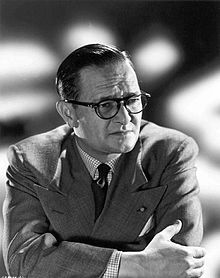
Back غريغ تولاند Arabic جريج تولاند ARZ Gregg Toland Catalan Gregg Toland Danish Gregg Toland German Gregg Toland Spanish گرگ تولند Persian Gregg Toland Finnish Gregg Toland French Gregg Toland Galician
Gregg Toland | |
|---|---|
 Gregg Toland in 1947 | |
| Born | Gregg Wesley Toland May 29, 1904 Charleston, Illinois, U.S. |
| Died | September 28, 1948 (aged 44) Los Angeles, California, U.S. |
| Occupation | Cinematographer |
| Years active | 1926–1948 |
| Known for | Innovative use of lighting and techniques such as deep focus |
| Notable work | Citizen Kane The Best Years of Our Lives The Grapes of Wrath The Long Voyage Home Wuthering Heights |
| Spouses | Helen Barclay
(m. 1934; div. 1945)Virginia Thorpe (m. 1945) |
| Children | 3 |
Gregg Wesley Toland (May 29, 1904 – September 28, 1948) was an American cinematographer known for his innovative use of techniques such as deep focus, examples of which can be found in his work on Orson Welles' Citizen Kane (1941), William Wyler's The Best Years of Our Lives (1946), and John Ford's The Grapes of Wrath, and The Long Voyage Home (both, 1940). He is also known for his work as a director of photography for Wuthering Heights (1939), The Westerner (1940), Ball of Fire (1941), The Outlaw (1943), Song of the South (1946) and The Bishop's Wife (1947).
Toland earned six Academy Award nominations for Best Cinematography, and won for his work on Wuthering Heights. He was voted one of the top ten most influential cinematographers in the history of film by the International Cinematographers Guild in 2003.[1][2]
- ^ "Top 10 Most Influential Cinematographers Voted on by Camera Guild" (Press release). Los Angeles: Yahoo Finance. PRNewswire. October 16, 2003. Archived from the original on October 19, 2003. Retrieved February 26, 2020.
- ^ "ICG Announces Top 10 Influential Cinematographers". Creative Planet Network. 2014-06-09. Archived from the original on 2017-09-07. Retrieved 2017-12-21.